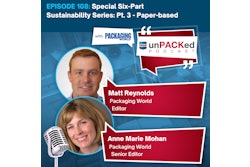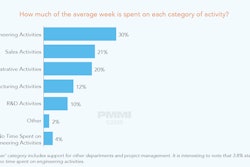These are also morphing from what once were linear, downstream efforts into circular, pull-through endeavors that recover packaging material at the end of the cycle, reinject it into the supply chain, and use it in new packaging. “Had we tried to do it alone, we couldn’t have done it at all,” is a common-thread sentiment heard in most of these collaborations.
Some models feature a third party at the center, holding together these circular supply flows. A regional entry into this category is the MBOLD film-recycling coalition. It’s moving from multi- to many-stakeholder. We’re also hearing more about Producer Responsibility Organizations (PROs), which also have a third-party management organization at their centers to help stakeholders better control their own destinies and potentially, keep less favorable forms of EPR (Extended Producer Responsibility) at bay. Here are a few other new collaborations in packaging.
Dow, WM, and Natura PCR. At the Plastics Packaging Conference (which featured a stellar four-channel waste collection and dual mechanical/chemical recycling system from PureCycle and ExxonMobil) last month, I heard about a pilot program for residential/curbside recycling of hard-to-recycle plastic films. It’s led by industry goliaths Dow and WM (Waste Management), plus film converter Natura PCR in which WM has a controlling stake. The project focuses on recoverable mono-material PE films that are common in households but difficult for MRFs to handle. Their recovery would unlock untapped PCR feedstock.
“Recycled plastic is only about 5% of the material that we collect every day in our customers’ bins. But it represents about 40% of the value,” said Brent Bell, president, WM, at the conference. “And it also represents nearly 100% of the conversations we have.”
Charter Next Generation (CNG) and Revolution Sustainable Solutions. Continuing the plastic film recycling theme, another one I heard about at the Plastics Recycling Conference was between CNG and Revolution. The former will offer the latter’s Encore food-grade PCR LLDPE resin for application in its film products, like stand-up pouches, pre-made bags, and rollstock for both horizontal and vertical applications. Revolution introduced Encore to the market in 2022 after receiving a Letter of No Objection (LNO) in December 2021 from the FDA. The LNO allowed for Revolution’s proprietary recycling method to produce PCR-LLDPE for flexible films in food contact at content levels up to 100% for all food packaging types under most conditions of use as defined by the FDA.
Kraft Heinz, Tesco, SABIC, and Berry Global. Heinz Beanz Snap Pots in the UK use product packaging with high-content chemically recycled PCR from SABIC, sourced from flexible films that had been dropped off by consumers at retailer Tesco’s in-store collection points. Spokespeople say this represents true circularity and continued adoption of new recycling technology—pyrolysis in this case. The 39% recycled plastic that the new Snap Pots contain was validated using an approach endorsed by ISCC. This makes it possible to track the amount and sustainability characteristics of materials used in the manufacturing process. The recycled material meets the requirements of food-contact safety regulations and provides a replacement for virgin polypropylene in the thin-wall pack with no compromise on processability or mechanical performance.
PepsiCo, Bryce Corp., Kaneka, CNG, Taghleef, Sun Chemical, and Printpack. At last month’s SNAXPO, we heard about a compostable Frito Lays chip bag that’s another example of collaboration. It uses polyhydroxyalkanoate (PHA), naturally produced by bio-fermentation, to create a cast copolymer called BHPH, or poly (3-hydroxybutyrate-co-3-hydroxyhexanoate), plus a layer of cellophane film. Every chef brings an ingredient to the soup, helping to add value along the supply chain with scale, machinability, barrier layer, thermal stability, printing and inks, adhesive and lamination, orientation, and more. With all of the elements in place to make a BPI industrial composability claim now or soon, the goal in commercialization for 2023 is to achieve an extra step: a home compostable claim.
“We talk a lot about collaboration, not competition, because these are the right things to do,” said Rob Cotton, R&D director, food packaging sustainability, PepsiCo at the show. PW






















